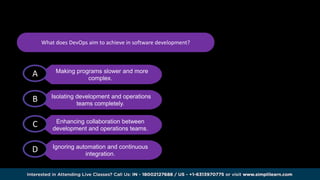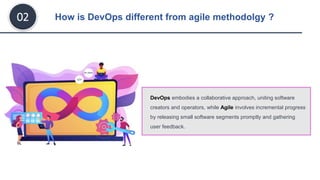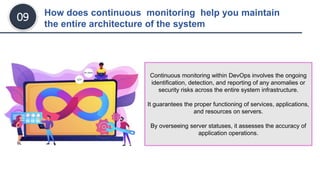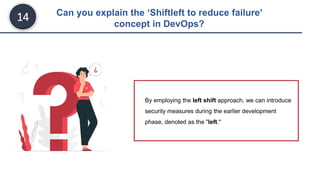Top 20 Devops Engineer Interview Questions And Answers For 2023 | Devops Tutorial | Simplilearn
- 2. Isolating development and operations teams completely. B Enhancing collaboration between development and operations teams. C Ignoring automation and continuous integration. D Making programs slower and more complex. A What does DevOps aim to achieve in software development?
- 3. What is DevOps ? DevOps combines the work of Developers and operations team, so that they may collaborate easily across the whole software development life cycle
- 4. What do you know about DevOps ? 01 DevOps is comparable to teamwork, enhancing collaboration between developers and operations for faster, error-reduced software development, similar to how a soccer team works together to achieve victory from planning to execution.
- 5. How is DevOps different from agile methodolgy ? 02 DevOps embodies a collaborative approach, uniting software creators and operators, while Agile involves incremental progress by releasing small software segments promptly and gathering user feedback.
- 6. What are the ways in which a build can we scheduled/run in Jenkins ? 03 • By source code management commits. • After the completion of other builds. • Scheduled to run at a specified time. • Manual build requests.
- 7. What are the different phases in DevOps ? 04 • Plan • Code • Build • Test • Integrate • Deploy • Operate • Monitor
- 8. Mention some of the core benefits of DevOps 05 Technical Benefits: • Continuous software delivery • Less complex problems to manage • Early detection and faster correction of defects Business Benefits: • Faster delivery of features • Stable operating environments • Improved communication and collaboration between the teams
- 9. How will you approach a project that needs to implement DevOps ? 06 Step 1 First, we look at how things are currently done and figure out where we can make them better. Step 2 Next, we create a small test to show that our plan works. Step 3 Now, we're all set to actually use DevOps. We do things like keeping track of different versions of our work, putting everything together, testing it etc.
- 10. How will you approach a project that needs to implement DevOps ? 07 Continuous Deployment Continuous Delivery Ensures code can be safely deployed on to production Every change that passes the automated tests is deployed to production Ensures business applications and services function as expected Makes software development and the release process faster Delivers every change to a production-like environment There is no explicit approval from a developer
- 11. Name three security mechanisms Jenkins uses to authenticate users. 08 • Jenkins uses an internal database to store user data and credentials. • Jenkins can use the Lightweight Directory Access Protocol (LDAP) server to authenticate users. • Jenkins can be configured to employ the authentication mechanism that the deployed application server uses.
- 12. How does continuous monitoring help you maintain the entire architecture of the system 09 Continuous monitoring within DevOps involves the ongoing identification, detection, and reporting of any anomalies or security risks across the entire system infrastructure. It guarantees the proper functioning of services, applications, and resources on servers. By overseeing server statuses, it assesses the accuracy of application operations.
- 13. What is the role of AWS in DevOps ? 10 • Adaptable Service • Designed for Expansion • Automated Operations • Enhanced Security • Extensive Partner Network
- 14. Name three important DevOps KPI’s. 11 • Meantime to failure recovery • Deployment frequency • Percentage of failed deployments
- 15. How is IaC implemented using AWS? 12 The shift from manual scripting and isolated testing to Infrastructure as Code (IaC), supported by AWS, enables developers to efficiently create, evaluate, and manage infrastructure components, enhancing development and swift implementation of changes.
- 16. Describe the branching strategies you have used. 13 • Release branching • Feature branching • Task branching
- 17. Can you explain the ‘Shiftleft to reduce failure’ concept in DevOps? 14 By employing the left shift approach, we can introduce security measures during the earlier development phase, denoted as the "left."
- 18. What is the Blue/Green Deployment Pattern ? 15 This approach focuses on smooth deployment by transitioning traffic between instances with updated code in a green environment while retaining the old version in blue, ensuring minimal downtime.
- 19. What is Continuous Testing ? 16 Continuous Testing automates tests throughout the software delivery process, promptly identifying business risks in the latest release, enhancing development efficiency, and accelerating productivity by integrating testing across all stages.
- 20. What are the benefits of Automation Testing ? 17 • Helps to save money and time. • Unattended execution can be easily done. • Huge test matrices can be easily tested. • Parallel execution is enabled. • Reduced human-generated errors, which results in improved accuracy. • Repeated test tasks execution is supported.
- 21. What is a Dockerfile used for ? 18 • A Dockerfile is used for creating Docker images using the build command. • With a Docker image, any user can run the code to create Docker containers. • Once a Docker image is built, it's uploaded in a Docker registry. • From the Docker registry, users can get the Docker image and build new containers whenever they want.
- 22. What is the purpose of reverting a commit that has already been pushed? 19 1. Remove or fix the bad file in a new commit and push it to the remote repository. Then commit it to the remote repository using: git commit –m "commit message" 2. Create a new commit that undoes all the changes that were made in the bad commit. Use the following command: git revert <commit id>
- 23. How do you find a list of files that have been changed in a particular commit? 20 git diff-tree –r {commit hash} Example: git diff-tree –r 87e673f21b • -r flag instructs the command to list individual files • commit hash will list all the files that were changed or added in that commit
Editor's Notes
- Distribution






















